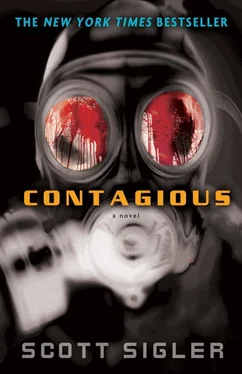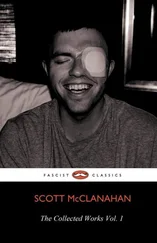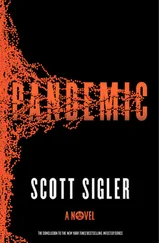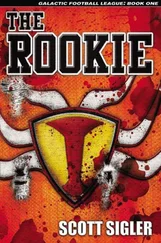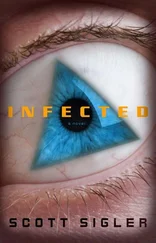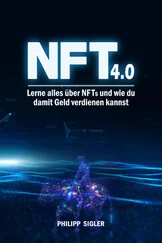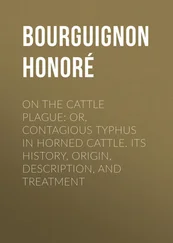Fourth Platoon held their position. If the hatchlings fled northwest, they’d run directly into the Fourth. If they ran due north, the Fourth would strafe their flank the whole way.
Predator drones circled low to the northeast, ready to launch Hellfire missiles that would either herd the hatchlings back into the action or kill them outright.
There was nowhere for the creatures to run.
Ogden watched through night-vision goggles, ready to adapt his strategy if something unexpected popped up.
But nothing did.
“Corporal Cope, status of air support?”
“Apaches, Predators and Strike Eagles still on station, sir,” Cope said. “Ready if you need them.”
“Very well.” Ogden watched as First Platoon moved in, methodically marching forward in a squad-after-squad leapfrog style that allowed a steady advance with constant fire on the enemy position. As First Platoon closed in, Third Platoon ceased fire to avoid any friendly casualties.
Two soldiers in each nine-man squad carried a less-lethal weapon. Like all the platoons, First had three squads, putting six less-lethal weapons into the initial infantry assault.
Such weapons had once been called non lethal, but in combat there was never a guarantee of preserving life. If you killed half the people you fought instead of all the people… well, then that wasn’t actually non lethal, now was it?
They didn’t know what would work against the hatchlings, so they’d brought two less-lethals: the sticky gun and ShockRounds.
The sticky gun fired jets of foam that would, theoretically, tangle the hatchlings’ tentacle-legs. The guns had been used with mixed success against people in Somalia—the “mixed” part was that the foam sometimes got in the targets’ eyes, blinding them, or clogged up their mouths. Put a clogged mouth together with hands immobilized by that same foam, and within minutes you had a dead target. Somewhat unacceptable against human targets, but hatchlings were a different story—it was worth the risk.
Compared to sticky guns, the ShockRounds seemed almost normal—5.56-millimeter bullets that delivered a concentrated electric charge. These were untested, but his men didn’t have to do anything different from what they were trained to do—point their weapons and fire.
He’d avoided Tasers. Their range was just too short for his comfort. If electricity even worked on the hatchlings, he had that covered with the ShockRounds.
He’d brought the less-lethals assuming that the hatchlings would behave the way they had in the last two engagements—once the fighting began, they would rush the ground troops and force hand-to-hand fighting. He hoped the lead hatchlings could be taken down with a less-lethal, then the rest could be slaughtered with concentrated conventional fire.
But this time the hatchlings didn’t attack.
Ogden watched the construct. The little monsters moved around the structure itself, scuttled across the ground surrounding it, but they didn’t come out to engage. One by one they shuddered as bullets tore through their plasticine skins. Gouts of their purple blood looked gray through the night-vision goggles, spraying on the ground in stringy strands before the hatchlings collapsed into twitching heaps. If any of those bullets were ShockRounds, they punched through the hatchlings just like normal ammo.
Why the hell weren’t they fighting back?
He had a bad feeling he knew why—another trap. Something new. He had no choice but to push forward and hope his attack plan allowed enough flexibility to react when that trap was sprung.
Corporal Cope lowered the handset and held it against his chest.
“Colonel, First and Second platoons report no resistance. Nothing is coming out to attack. They estimate enemy forces are down to maybe five or six individuals.”
“Order immediate cease-fire of lethal weaponry,” Ogden barked. “Less-lethals move in slowly. Sticky guns first, but tell them to also try the Shock-Rounds and see if they have any effect. All squads are to try and take one alive. Tell the squad leaders no lethal fire unless they specifically order it.”
The last shots echoed through the woods as soldiers stopped firing the M4 carbines and M249 squad automatic weapons.
Ogden turned to face Mazagatti. “Sergeant Major, let’s move in. I want to see this thing up close.”
“Sir,” Mazagatti said, “I wouldn’t be doing my job if I didn’t say that it’s a stupid idea for you to get that close. Again. Sir.”
“Understood,” Ogden said. “I’m feeling lucky. Again. Proceed.”
Mazagatti flashed hand signals to Ogden’s personal squad. Ogden drew his sidearm and followed. Corporal Cope trailed a step behind and to the right, radio at the ready.
With the gunfire gone, Ogden heard the nonlethals: the whoosh of the foam guns and the normal-sounding reports of ShockRounds. He followed the platoon to within seventy-five yards of the construct before he ordered all platoons to halt. First Platoon was only forty yards away now; a quick sprint would take them right into the construct.
Ogden saw the hatchlings scurrying around inside the glowing arches. Triangular bodies, three tentacle-legs that looked like muscular black pythons. The point of the shortest hatchling would come up just to his knee, the tallest one to his chin.
The sticky foam seemed to be working, reducing two hatchlings to weakly wiggling lumps on the muddy ground, unable to pull those tentacle-legs loose. He counted another five hatchlings moving freely, but they didn’t engage. Did they fear the weapons? Were they aware that the less-lethals might isolate them? If so, why didn’t they at least run north? Why didn’t they try something ?
Ogden again sensed a trap—the enemy wasn’t behaving rationally or consistently with the previous two encounters. But trap or no trap, he had his orders.
“Corporal Cope, tell First Platoon to move in. Capture the enemy by hand.”
Cope spoke into his handset and relayed the orders.
Thirty-five yards ahead, Ogden watched a line of men rise up and silently walk forward. The three foam-gunners led the charge, each flanked on the immediate left and right by comrades carrying M4s. The rest of each respective squad fanned out on either side of this lead element.
Ogden watched. The hatchlings seemed to sense the advance. They clustered tighter around the base of the smallest arch.
First Platoon closed to thirty yards. Then twenty. The line of men rushed forward through the snow, moving in….
A spark flashed somewhere beneath the hatchlings, at the base of the arch. Was this it? Was it opening up?
Another flash, then a steady glow backlit the hatchlings. This new illumination showed only at the base of one arch. It flickered, jumped, then Ogden recognized it for what it was—fire.
Blue-flamed, not orange, but fire nonetheless. The flames crawled up the arch as if it were made of tinder, shooting along the curve almost like a flamethrower.
All five of the free-moving hatchlings jumped into the flames, igniting themselves. They scampered toward the stuck hatchlings, setting them aflame before running into the other arches and the loglike things, spreading the blaze. Within seconds the whole construct danced with crackling blue flames.
Heat pushed his soldiers back, stopping their advance as surely as a wall.
“Tell the men to fall back and set up a perimeter at fifty yards,” Ogden said. “And don gas masks—we don’t know what kind of fumes that thing might put out.”
It wasn’t an ambush. He had a feeling it was something worse.
Not a trap… a decoy.
Dew arrived at Tad’s house only a few seconds behind two unmarked gray vans. The vans parked on the street while he drove his Lincoln onto the wet lawn just before the vans unloaded hazmat-suited gunmen. No one parked in the driveway; they needed to keep that open for the Margo-Mobile.
Читать дальше
